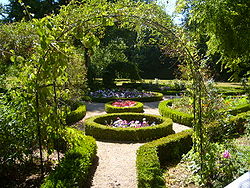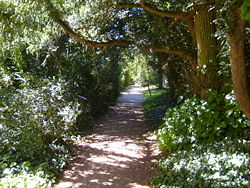
House of George Sand
Encyclopedia




George Sand
Amantine Lucile Aurore Dupin, later Baroness Dudevant , best known by her pseudonym George Sand , was a French novelist and memoirist.-Life:...
(1804-1876) is located in the village of Nohant, in the Indre
Indre
Indre is a department in the center of France named after the river Indre. The inhabitants of the department are called Indriens.-History:Indre is one of the original 83 departments created during the French Revolution on March 4, 1790...
Department of France. It was purchased by the French state in 1952, and has been preserved as it was when Sand wrote many of her books there and hosted many of the most important artists and writers of her time, including Frederic Chopin
Frédéric Chopin
Frédéric François Chopin was a Polish composer and virtuoso pianist. He is considered one of the great masters of Romantic music and has been called "the poet of the piano"....
, Balzac, Turgenev, and Delacroix
Eugène Delacroix
Ferdinand Victor Eugène Delacroix was a French Romantic artist regarded from the outset of his career as the leader of the French Romantic school...
. The writer and her family are buried in a small cemetery between the garden and the village church. The gardens are classified by the French Ministry of Culture as among the Notable Gardens of France
Notable gardens of France
The Remarkable Gardens of France is intended to be a list and description, by region, of the over two hundred gardens classified as "Jardins remarquables" by the French Ministry of Culture and the Comité des Parcs et Jardins de France...
. The house is open to the public, and is managed by the Centre des monuments nationaux
Centre des monuments nationaux
The Centre des monuments nationaux is a French government body which conserves, restores, and manages historic buildings and sites which are the property of the French state...
.
History
The village of 'Nohan' is mentioned in French chronicles as early as 1228. A fortified manor house stood on the site, and was reconstructed between 1450 and 1452. Two of the original towers are part of the farm of the present chateau. In 1767 the land and house was purchased by Pierre Pearron, who reconstructed the manor in its present form. It was sold in 1793, during the French RevolutionFrench Revolution
The French Revolution , sometimes distinguished as the 'Great French Revolution' , was a period of radical social and political upheaval in France and Europe. The absolute monarchy that had ruled France for centuries collapsed in three years...
, to Madame Dupin de Francueil, the illegitimate daughter of the French military hero Marechal Maurice de Saxe, and granddaughter of August II the Strong, the King of Poland, grandmother of George Sand, who laid out the gardens and built the main stairway.
In 1808 Aurore Dupin (the future George Sand), then just four years old, came to live with her grandmother after the accidental death of her father, Maurice Dupin, an officer in the French army.
George Sand's grandmother was not happy with what she considered the excessive exuberance and free ways of the child, and sent her to a convent. When Aurore was sixteen her grandmother was paralyzed by a stroke, and she returned to Nohant to take care of her. When her grandmother died in 1821, Aurore received the house as an inheritance. The following year, she married Casimir Dudevant, who was nine years her senior. They had two children, Maurice (born 1823) and Solange (born 1828).
In 1830, George Sand fell in love with Jules Sandeau, and left her husband to move to Paris. There she wrote two novels, Indiana and Lélia under the name George Sand, which made her famous. In her absence her husband took possession of the house. She regained it after a lawsuit, and moved back into the house in 1837.
From 1837 until her death in 1876, Sand spent long summers, usually from May until November, at the house, where she entertained many of the most famous artists of the time, including composer Franz Liszt
Franz Liszt
Franz Liszt ; ), was a 19th-century Hungarian composer, pianist, conductor, and teacher.Liszt became renowned in Europe during the nineteenth century for his virtuosic skill as a pianist. He was said by his contemporaries to have been the most technically advanced pianist of his age...
, writers Honoré de Balzac
Honoré de Balzac
Honoré de Balzac was a French novelist and playwright. His magnum opus was a sequence of short stories and novels collectively entitled La Comédie humaine, which presents a panorama of French life in the years after the 1815 fall of Napoleon....
and Gustave Flaubert
Gustave Flaubert
Gustave Flaubert was a French writer who is counted among the greatest Western novelists. He is known especially for his first published novel, Madame Bovary , and for his scrupulous devotion to his art and style.-Early life and education:Flaubert was born on December 12, 1821, in Rouen,...
, and painter Eugène Delacroix
Eugène Delacroix
Ferdinand Victor Eugène Delacroix was a French Romantic artist regarded from the outset of his career as the leader of the French Romantic school...
. From 1839 until 1847, Frederic Chopin lived with her in the house, writing his Fantasie in fa Minor, the Sonata Funebre, the Nocturnes
Nocturnes (Chopin)
The Chopin nocturnes constitute 21 short pieces for solo piano written by Frédéric Chopin between 1827 and 1846. They are generally considered among the finest short solo works for the instrument and hold an important place in contemporary concert repertoire...
from opus 37, the Mazurkas
Mazurkas (Chopin)
Over the years 1825-1849, Frédéric Chopin wrote at least 69 mazurkas, based on the traditional Polish dance :* 58 have been published** 45 during Chopin's lifetime, of which 41 have opus numbers...
from opus 41.
Many of her most famous novels, including Consuelo, La Mare au Diable, and Le Meunier d'Angibault, were written in the house, and most of her novels are set in the Berry countryside and villages around Nohant.
After the death of George Sand, the house passed to her son Maurice Dudevant (1823-1889). The house remained in the family until the death of Sand's granddaughter, Aurore Dudevant (1866-1961.) It was classified as a National Historical Monument of France in 1952, and was opened to the public in 1961.

